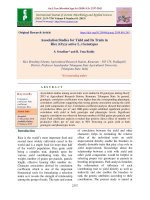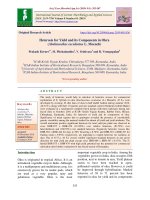Genetic variability studies in segre gating population (F2) of a cross, Phule utkarshi × Arka anamika for yield and its attributing traits in okra [Abelmoschus esculentus (L.) Moench]
Bạn đang xem bản rút gọn của tài liệu. Xem và tải ngay bản đầy đủ của tài liệu tại đây (155.91 KB, 5 trang )
Int.J.Curr.Microbiol.App.Sci (2019) 8(9): 1020-1024
International Journal of Current Microbiology and Applied Sciences
ISSN: 2319-7706 Volume 8 Number 09 (2019)
Journal homepage:
Original Research Article
/>
Genetic Variability Studies in Segre gating Population (F2) of a Cross,
Phule Utkarshi × Arka Anamika for Yield and its Attributing Traits in
Okra [Abelmoschus esculentus (L.) Moench]
S. R. Priyanka*, T. H. Gowda, and S. Gangaprasad
Department of Genetics and Plant Breeding, College of Agriculture, Shivamogga
University of Agricultural and Horticultural sciences, Shivamogga, India
*Corresponding author
ABSTRACT
Keywords
Okra, Genetic
variability, GCV,
PCV, Heritability
and Genetic
advance.
Article Info
Accepted:
14 August 2019
Available Online:
10 September 2019
The present investigation was aimed to assess the extent of genetic
variability in 250 F2 population of cross, Phule Utkarshi × Arka Anamika
for fruit yield and its component traits along with parents as checks which
was carried out at the ZAHRS Navile, Shivamogga during kharif-2018. The
analysis of variance revealed the existence of significant amount of
variability for all the traits studied in the segregating population. High PCV
and GCV were observed for number of branches per plant, number of fruits
per plant, fruit weight, number of seeds per fruits, number of picking and
yield per plant. High heritability coupled with high genetic advance as
percent mean was observed for traits like plant height at maturity, number
of fruits per plant, fruit weight, fruit width, fruit length, number of seeds
per fruit, number of picking and yield per plant which indicates that
preponderance of additive genes.
Introduction
Okra [Abelmoschus esculentus (L.) Moench]
is an economically important fast growing
annual vegetable crop belongs to Malvaceae
family, it is widely cultivated throughout
tropical to the subtropical region of the world
including countries like India, Turkey, Iran,
Western Africa, Ethiopia and Southern United
States. Okra is widely grown during summer
and rainy seasons for its tender green fruits. It
is one of the widely consumed vegetable crops
in India. It is also known by many local names
in different parts of the world. It is called
Lady’s finger in England, Gumbo in the
U.S.A. and Bhendi in India. Fresh and tender
fruits contain 88 per cent moisture and a large
number of chemical components including
vitamin A (88 IU), vitamin B (63 IU) and
vitamin (C 13 mg/100 gm) (Aykroyd, 1941).
Immature100 g of okra fruits contain 3.1 K
calorie energy, 1.80 g protein, 90.00 mg
calcium and 1.0 mg iron (Gopalan et al.,
2007). Its mucilage has medicinal applications
1020
Int.J.Curr.Microbiol.App.Sci (2019) 8(9): 1020-1024
as well when used as a plasma replacement or
in detoxification by binding to cholesterol and
bile acid carrying toxins (Gemede et al.,
2015). Seeds of okra contain oil content
(17.30 %) it is a nutritious ingredient of cattle
feed (Martin and Ruberte, 1979) and contain
20 to 23 per cent crude protein (Berry et al.,
1988). It has ayurvedic medicinal properties.
Its leaves are used for preparing a medicament
to reduce inflammation. It is an excellent
source of iodine for control of goiter (Chadha,
2001). The stem and roots of okra are used as
cane juice clarifier from which brown sugar or
jaggery (gur) is prepared (Chauhan, 1972) and
is also used in the paper industry.
Increase in demand and the area under
cultivation necessitates development of
improved varieties in this crop. Improvement
of the crop for yield and yield attributing
characters depends upon variability present in
crop and breeding method used. Genetic
variability is prerequisite for any successful
breeding programme. The variability that is
present naturally in population was considered
enough for crop improvement. Lack of useful
variability necessitates the creation of
variability through different means like
hybridization or hybridization followed by
selection in segregating population is very
useful. The present investigation was aimed to
assess the genetic variability in segregating
population for yield improvement in okra.
Materials and Methods
The experimental materials consist of 250 F2
plants which were developed from the cross,
Phule Utkarshi × Arka Anamika and parents
of the cross were used as checks, which was
carried out at D-9 block, College of
Agriculture
ZAHRS,
University
of
Agricultural and Horticultural Sciences,
Shivamogga. All the 250 F2 plants along with
checks were sown in augmented design with a
spacing of 60 × 30 cm in a 3-meter row. A
total of 25 rows accommodated all the 250
plants. After every five rows, commercially
cultivated verities Phule Utkarshi and Arka
Anamika were sown as checks. The
observations were recorded on all the
individually tagged 250 plants on thirteen
characters (Table.1). The data recorded from
the experiment was subjected to various
statistical analysis to estimate phenotypic and
genotypic coefficients of variation, heritability
in broad sense, genetic advance as per cent of
mean as per Burton and De vane (1953).
Results and Discussion
The analysis of variance showed that each
plant differed significantly among themselves
for all the thirteen traits in the material
studied. The mean, range, genotypic (GCV)
and phenotypic (PCV) coefficients of
variation, heritability and genetic advance as
per cent of mean for all the traits are presented
in Table 1. Highest range observed for plant
height at maturity (50.00 to 137.00 cm),
number of internodes (6.00 to 23.00), number
of fruits per plant (1.00 to 11.00), fruit weight
(4.50 to 41.66 g), fruit width (10.12 to 45.60
cm), number of seeds per fruit (18.00 to
95.00), and yield per plant (24.00 to 260.00 g)
suggesting that these characters can be
improved by individual plant selection. The
magnitude of PCV was higher than that of
GCV for all the traits indicating that all the
thirteen traits were influenced by the
environment. The GCV and PCV were high
for number of branches per plant (38.00 %,
45.81 %), number of fruits per plant (35.15 %,
44.90 %), fruit weight (33.32 %, 34.53 %),
number of seeds per fruits (20.16 %, 29.98 %),
number of picking (29.76 %, 41.97 %) and
yield per plant (39.62 %, 40.14 %) ; moderate
for plant height at maturity (12.19 %, 18.94
%), number of internodes (13.22 %, 22.19 %)
fruit width (16.84 %, 19.09 %) and fruit length
(17.60 %, 16.65 %) and low for days to first
flowering (2.02 %, 3.06 %), number of ridges
per fruit (7.90 %, 10.69 %) and test weight
(8.46 %, 16.59 %).
1021
Int.J.Curr.Microbiol.App.Sci (2019) 8(9): 1020-1024
Table.1 Genetic variability for yield and yield attributing traits of F2 segregating population in okra
Range
Max.
Min.
Mean± SEm of F2
Coefficient
of h2 (bs)(%)
variation
PCV (%) GCV (%)
33.00
50.00
47.00
137.00
44.95±0.08
73.42±0.87
3.06
18.94
2.02
12.19
45.32
75.30
2.86
29.39
1.00
4.00
1.37±0.03
45.81
38.10
36.74
34.72
6.00
23.00
10.42±0.15
22.19
4
1.00
11.00
4.50±0.12
44.90
5
4.50
41.66
18.16±0.39
34.53
6
10.12 45.60
15.36±0.18
19.09
7
7.00
16.88
11.90±0.12
16.65
8
5.00
9.00
5.17±0.03
10.69
9
18.00 95.00
47.27±0.89
29.98
10
1.00
9.00
4.06±0.10
41.97
11
6.00
10.00
7.89±0.08
16.59
12
24.00 260.00 124.01±3.14
40.14
13
Where,
SEm= Standard error of mean
PCV= Phenotypic coefficient of variation
GCV=Genotypic coefficient of variation GAM=Genetic advance as per cent mean
13.22
35.15
33.32
16.84
17.60
7.90
20.16
29.76
8.46
39.62
51.81
75.55
75.88
92.07
83.56
51.02
88.10
75.98
41.72
97.42
24.46
69.88
53.98
36.21
28.67
11.23
54.42
65.69
14.26
80.57
Sl.
No.
1
2
3
Characters
Days to first flowering
Plant height at maturity
(cm)
Number of branches per
plant
Number of internodes
Number of fruits per plant
Fruit weight (g)
Fruit width (cm)
Fruit length (cm)
Number of ridges per fruit
Number of seeds per fruit
Number of picking
Test weight (g)
Yield per plant (g)
1022
GAM
(%)
h2(bs) =Heritability broad sense
Int.J.Curr.Microbiol.App.Sci (2019) 8(9): 1020-1024
The low values indicate narrow range of
variation for these characters and provides
very least scope for improvement through
selection. Similar observations were also made
by Gangashetty et al., (2010), Adeoluwa and
Kehinde (2011), Kumar et al., (2012) and
Syfullah et al., (2018).
The estimates of heritability in broad sense
were high for characters studied viz., plant
height at maturity (45.32 %), number of fruits
per plant (75.55 %), fruit weight (75.88 %),
fruit width (92.07 %), fruit length (83.56 %),
number of seeds per fruits (88.10 %), number
of picking (75.98 %) and yield per plant
(97.42 %) and moderate for days to first
flowering (45.32 %), number of branches per
plant (36.74 %), number of internodes (51.81
%), number of ridges per fruit (51.02 %) and
test weight (41.72 %). The high to moderate
estimates of heritability for all these traits
suggested that selection based on phenotypic
performance would be more effective. Prakash
and Pitchaimuthu. (2010) and Ahamed et al.,
(2015) also observed high heritability for fruit
yield and its components.
The information on heritability alone may be
misleading but when used in combination with
genetic advance, the utility of heritability
estimate and efficiency increases. In the
present study, high genetic advance coupled
with high to moderate heritability was
observed for all the studied characters except
days to first flowering (2.86 %), number of
ridges per fruit (11.23 %) and test weight
(14.26 %). It indicates that higher response for
selection of high yielding genotypes as these
traits are governed by additive gene actions
and selection might be effective. These
findings are in agreement with the earlier
results of Nwangburuka et al., (2014) and
Syfullah et al., (2018).
Heritability coupled with genetic advance as
per cent mean were more useful than
heritability alone in predicting the resultant
effect for selecting the best individual. High
heritability coupled with high genetic advance
as per cent mean for traits like plant height at
maturity, number of branches per plant,
number of internodes, number of fruits per
plant, fruit weight, fruit width, fruit length,
number of seeds per fruits, number of picking
and yield per plant (Table.1) noticed might be
assigned to additive gene effects governing
their inheritance and phenotypic selection for
their improvement could be achieved by
simple breeding methods. Thus, the fruit yield
in okra can be improved by selecting plant
height at maturity, number of branches per
plant, number of internodes, number of fruits
per plant, fruit weight and fruit width
simultaneously in the present study.
References
Adeoluwa, O. O. and Kehinde, O. B., 2011,
Genetic variability studies in West
African okra [Abelmoschus caillei].
Agric. Biol. J. N. Am., 2(10): 13261335.
Ahamed, K., Akter, U. B., Ara, N., Hossain,
M. F. and Moniruzzaman, M., 2015,
Heritability, correlation and path
coefficient analysis in fifty seven okra
genotypes. Int. J. of Appl. Sci., 3(1):
127–133.
Aykroyd, 1941, Health bulletin, Nutritional
research Lab., pp. 21-26.
Burton, G. W. and De Vane, E. H., 1953,
Estimating heritability in tall Fescue
(Festuca
aurundinacea)
from
replicated clonal material. Agron. J.,
45: 478-481.
Chadha, K.L., 2001, Hand book of
Horticulture, ICAR publication., p.
422.
Chauhan, V. S., 1972, Vegetable production in
India. 3rd Edition, Textbook publishers
Ramprasad and sons., p. 239.
Gangashetty, P. I., Shanthakumar, G.,
1023
Int.J.Curr.Microbiol.App.Sci (2019) 8(9): 1020-1024
Salimath, P. M. and Sridevi, O., 2010,
Comparison of variability, nature and
magnitude
of
association
of
productivity traits in single and double
cross
progenies
of
bhendi
[Abelmoschus
esculentus (L.)
Moench]. Karnataka J. Agric. Sci.,
23(3): 413-417.
Gemede, H. F., Ratta, N., Haki, G. D.,
Woldegiorgis, A. Z. and Beyene, F.,
2015, Nutritional quality and health
benefits of Okra [Abelmoschus
Esculentus]: A Review. Global J.
Medical Res.: K Interdisciplinary.,
14(5): 29–37.
Gopalan, C., Rama Sastri, B. V. and
Balasubramanian, S., 2007, Nutritive
value of Indian Foods, National
Institute of Nutrition (NIN), ICMR, pp
1-2.
Kumar, S., Annapurna, Yadav Y.C. and
Singh R., 2012, Genetic variability,
heritability,
genetic
advance,
correlation and path analysis in okra.
Hort Res. Spec., 1(2): 139-144.
Martin, F. W. and Ruberte, R., 1979, Milling
and use of okra seed meal at the
household level. J. of Agric., 62: 1-7.
Nwangburuka, C. C., Denton, O. A., Kehinde,
O. B., OJO, D. K. and Popoola, A. R.,
2014,
Genetic
variability
and
heritability
in
cultivated
okra
[Abelmoschus
esculentus
(L.)
Moench]. Spanish J. Agril Res., 10(1):
123-129.
Prakash, K. and Pitchaimuthu, M., 2010,
Nature and magnitude of genetic
variability and diversity studies in okra
[Abelmoschus
esculentus
(L.)
Moench]. Electronic J. Plant Breed.,
1(6): 1426-1430.
Syfullah, K., Sani, M. M. H., Nasif, S. O.,
Parvin, S., Rony, M. M. H., Islam, M.
S. and Hossain, M. S., 2018, Genetic
variability,
heritability,
character
association
and
morphological
diversity in okra [Abelmoschus
esculentus (L.) Moench]. Int J. Pt and
Soil Sci., 25(6): 1-11.
How to cite this article:
Priyanka, S. R., T. H. Gowda, and Gangaprasad, S. 2019. Genetic Variability Studies in Segre
gating Population (F2) of a Cross, Phule Utkarshi × Arka Anamika for Yield and its Attributing
Traits in Okra [Abelmoschus esculentus (L.) Moench]. Int.J.Curr.Microbiol.App.Sci. 8(09):
1020-1024. doi: />
1024
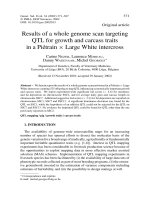
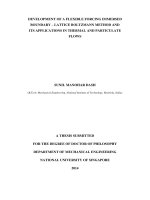
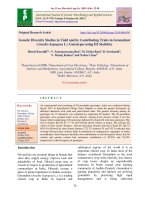
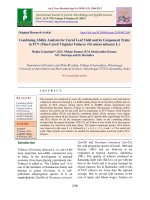
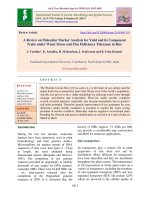
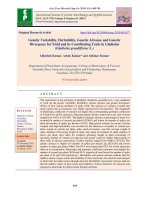
![Genetic variability studies in F2 segregating populations for yield and its component traits in Okra [Abelmoschu sesculentus (L.)Moench]](https://media.store123doc.com/images/document/2020_01/13/medium_nxs1578931693.jpg)
